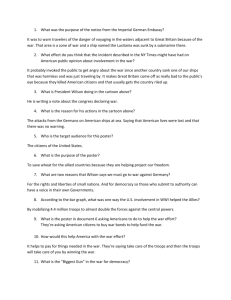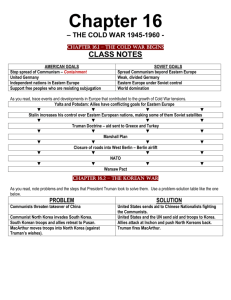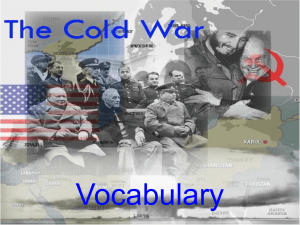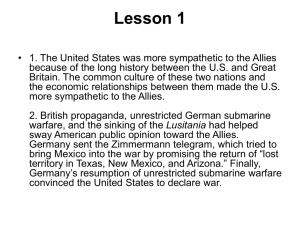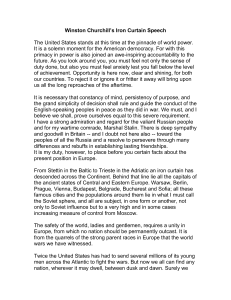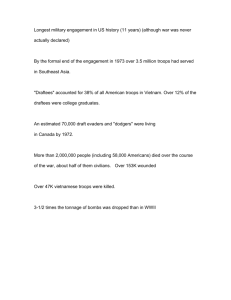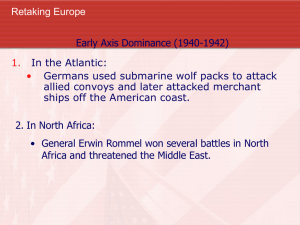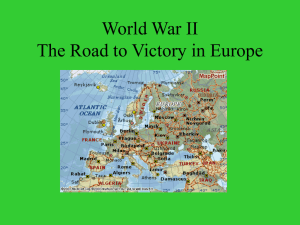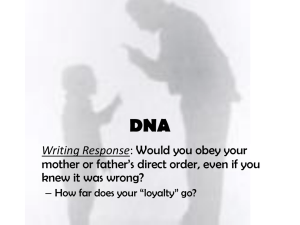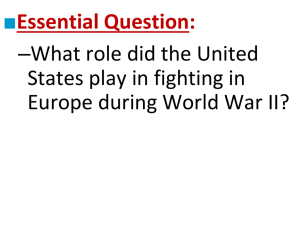Test CH 15-16 Corrections
advertisement
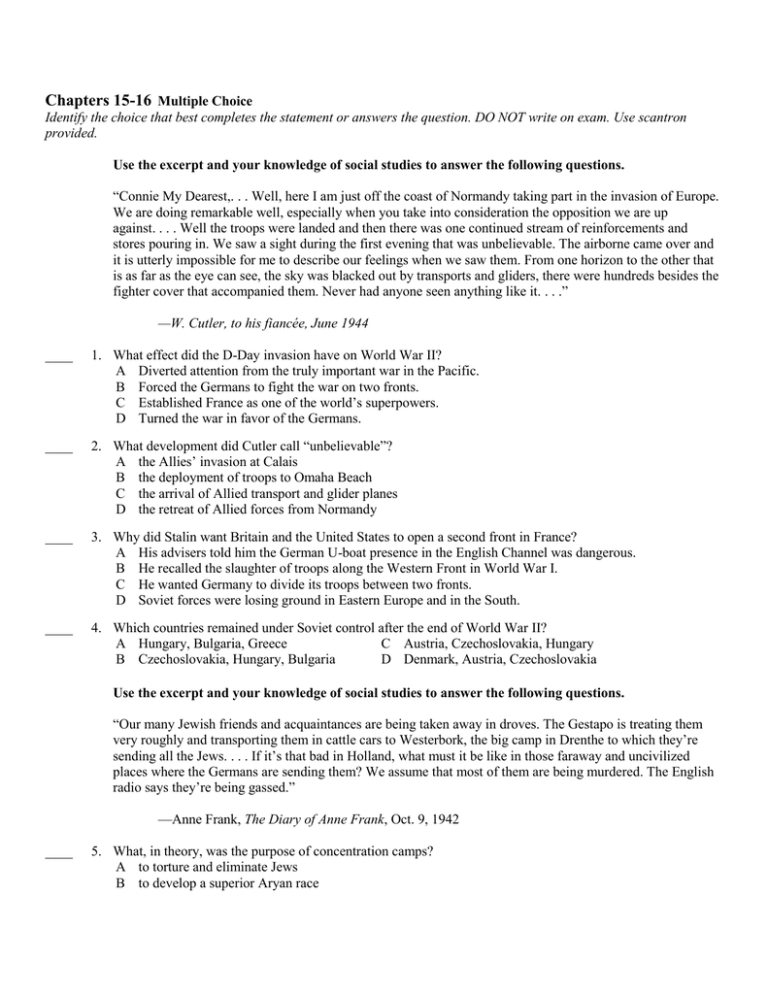
Chapters 15-16 Multiple Choice Identify the choice that best completes the statement or answers the question. DO NOT write on exam. Use scantron provided. Use the excerpt and your knowledge of social studies to answer the following questions. “Connie My Dearest,. . . Well, here I am just off the coast of Normandy taking part in the invasion of Europe. We are doing remarkable well, especially when you take into consideration the opposition we are up against. . . . Well the troops were landed and then there was one continued stream of reinforcements and stores pouring in. We saw a sight during the first evening that was unbelievable. The airborne came over and it is utterly impossible for me to describe our feelings when we saw them. From one horizon to the other that is as far as the eye can see, the sky was blacked out by transports and gliders, there were hundreds besides the fighter cover that accompanied them. Never had anyone seen anything like it. . . .” —W. Cutler, to his fiancée, June 1944 ____ 1. What effect did the D-Day invasion have on World War II? A Diverted attention from the truly important war in the Pacific. B Forced the Germans to fight the war on two fronts. C Established France as one of the world’s superpowers. D Turned the war in favor of the Germans. ____ 2. What development did Cutler call “unbelievable”? A the Allies’ invasion at Calais B the deployment of troops to Omaha Beach C the arrival of Allied transport and glider planes D the retreat of Allied forces from Normandy ____ 3. Why did Stalin want Britain and the United States to open a second front in France? A His advisers told him the German U-boat presence in the English Channel was dangerous. B He recalled the slaughter of troops along the Western Front in World War I. C He wanted Germany to divide its troops between two fronts. D Soviet forces were losing ground in Eastern Europe and in the South. ____ 4. Which countries remained under Soviet control after the end of World War II? A Hungary, Bulgaria, Greece C Austria, Czechoslovakia, Hungary B Czechoslovakia, Hungary, Bulgaria D Denmark, Austria, Czechoslovakia Use the excerpt and your knowledge of social studies to answer the following questions. “Our many Jewish friends and acquaintances are being taken away in droves. The Gestapo is treating them very roughly and transporting them in cattle cars to Westerbork, the big camp in Drenthe to which they’re sending all the Jews. . . . If it’s that bad in Holland, what must it be like in those faraway and uncivilized places where the Germans are sending them? We assume that most of them are being murdered. The English radio says they’re being gassed.” —Anne Frank, The Diary of Anne Frank, Oct. 9, 1942 ____ 5. What, in theory, was the purpose of concentration camps? A to torture and eliminate Jews B to develop a superior Aryan race C to convert Jews into members of the Third Reich D to take the place of death camps ____ 6. Following the battle of Stalingrad, A Hitler’s plans of dominating Europe had ended. B German troops continued their blitzkrieg eastward. C Hitler controlled the Caucasus oil fields. D both German and Soviet troops refused to surrender. ____ 7. As American forces approached Japan, Japanese forces A won an important victory in the Philippines. B fought to the end, preferring to kill themselves rather than surrender. C conquered every island the United States held. D surrendered quickly and joined the Allied forces. ____ 8. In 1950, what event began the conflict on the Korean peninsula? A The South Korean army invaded north of the 38th parallel. B The Chinese army invaded south of the 38th parallel. C U.N. forces fought off the invading army from the North. D The North Korean army invaded south of the 38th parallel. ____ 9. General MacArthur chose what port city for a counterattack against North Korea? A Pyngyang C Pusan B Seoul D Inchon ____ 10. Japanese Americans generally faced more restrictions than Italian or German Americans during World War II because they A greatly outnumbered other immigrant groups. B were more isolated from other Americans. C lived along the West Coast. D held more political power in the United States. Use the graph and your knowledge of social studies to answer the following questions. ____ 11. Between which two years was there the biggest increase in the number of women entering the workforce? A 1942 and 1943 C 1944 and 1945 B 1941 and 1942 D 1943 and 1944 ____ 12. What was an effect that World War II had on American women? A The war accelerated a trend toward white-collar employment for women. B The war made it difficult for women to forge new relationships because many now spent their time working. C The war promoted the common practice that a woman quit her job once she was married. D The war did little to increase the confidence, knowledge, and opportunities for women workers. ____ 13. Which two nations emerged as the strongest following World War II? A China and Japan C Britain and France B the Soviet Union and the United States D Germany and Poland ____ 14. What was one place on the globe where the Cold War was “hot” and U.S. soldiers fought and died? A Korea C China B Egypt D Hungary ____ 15. How did the American public view General MacArthur after President Truman fired him? A They were angry that he had miscalculated in the war. B They still saw him as a hero. C They thought he was too old to still be on active duty. D They thought he was a traitor. Use the table and your knowledge of social studies to answer the following questions. ____ 16. Which two countries were members of NATO? A Denmark and Hungary C Italy and United Kingdom B West Germany and East Germany D United States and Soviet Union ____ 17. Many Jews were prevented from leaving Germany because A transportation to other countries was too expensive. B U.S. officials denied them the right to leave the country. C they needed to stay to protect their businesses and families. D some countries refused to accept them during the Great Depression. Use the chart and your knowledge of social studies to answer the following questions. ____ 18. The United States stockpiled more than 10,000 weapons by 1971. When did the Soviet Union reach the same number of nuclear weapons? A 1970 C 1977 B 1990 D 1957 ____ 19. How did population shifts change American life during the war? A California lost 2 million residents who left to seek work in wartime industries. B The South lost about a million people as a whole to cities such as Chicago and Gary. C The Southwest became a growing cultural, social, economic, and political force. D Older industrial cities in the North, such as Detroit and Cleveland, began to decline. ____ 20. After President Eisenhower withdrew his offer to fund the Aswan Dam, Egyptian President Nasser A nationalized the Suez Canal. B closed the Suez Canal. C attacked the United States. D turned to the Soviet Union for the money. Use the timeline and your knowledge of social studies to answer the following questions. ____ 21. What event in 1956 threatened the flow of Middle Eastern oil to Europe? A the launch of Sputnik B Khrushchev becoming leader of the U.S.S.R. C the Suez Canal crisis D Hungarian revolt ____ 22. What was the Eisenhower Doctrine? A The United States would liberate the countries behind the iron curtain. B The United States would use force to help any Middle Eastern nation threatened by communism. C The United States would nationalize the Suez canal. D The United States would recognize the People’s Republic of China. ____ 23. What led to Senator McCarthy’s downfall? A the uncovering of financial irregularities in his Senate campaign B revelations that he was a communist himself C the broadcast of the McCarthy hearings on television D the discovery that some of the people he had accused were innocent ____ 24. FDR created the Office of Price Administration (OPA), which A had the authority to control wages and set maximum prices. B issued war bonds to help fund the war effort. C levied a 5 percent tax on all working Americans. D encouraged the media to make movies that boosted morale. ____ 25. What did American leaders learn at Kasserine Pass in North Africa? A They needed aggressive officers and troops better trained for desert fighting. B They were unprepared for an invasion across the English Channel. C Rommel’s forces had the supplies needed for a successful assault. D Forcing Germany out of North Africa would pave the way for an invasion of Italy. ____ 26. During the 1945 conference in Potsdam, A Churchill replaced Clement Atlee as prime minister of Britain. B the Big Three decided that Poland, Bulgaria, and Romania would be independent. C Stalin reneged on his pledge to enter the war against Japan in the Pacific. D the Big Three formalized the plan to divide Germany into four zones of occupation. ____ 27. What was Hitler’s “final solution”? A a plan to force all “undesirable” groups to become “useful members” of the Third Reich B the construction of walled ghettos in Polish cities to hold “undesirable” groups C a series of fake experiments conducted on topics such as oxygen deprivation D a plan to exterminate all Jews living in Third Reich-controlled regions ____ 28. The United Nations (U.N.) was organized to A encourage cooperation between the Great Powers. B punish Germany for its role in the war. C preserve the absolute equality of all nations. D reprimand soldiers for committing war crimes. Use the table and your knowledge of social studies to answer the following questions. ____ 29. Which of the following is a reason for communist victory in China? A The Nationalists were reluctant to fight. B The communists refused to feed the people. C Mao Zedong fled the mainland. D The United States sent U.S. troops to aid the Nationalists. ____ 30. One of the effects of the Battle of the Bulge was that A Soviet troops avoided the Oder River outside Berlin. B Germany used its reserves and demoralized its troops in the battle. C Germany prolonged the time before its surrender to the Allies. D British and American troops had little difficulty approaching Berlin. ____ 31. What is one result of World War II? A The United States had the world’s largest military force. B Britain, France, and Spain began to seek new territories. C Colonial peoples renewed their drive for independence from European powers. D General Douglas MacArthur supervised the rebuilding of Germany. ____ 32. Where did Senator McCarthy first announce that the State Department was infested with communists? A at a campaign rally B as part of a radio broadcast C at a communist party rally D on the Senate floor ____ 33. At the 1942 Wannsee Conference, Reinhard Heydrich A planned to carry out bogus medical experiments on prisoners. B outlined a plan to exterminate about 11,000,000 Jews. C decided to invade large territories that were home to millions of Jews. D determined the need to build additional concentration camps. ____ 34. In the years closely following World War II, many African Americans A had difficulty finding jobs in the struggling economy. B wanted the government to play a smaller role in economic affairs. C renewed their efforts to work for civil rights. D called for a return to isolationism. ____ 35. The Allies adopted a “Europe First” strategy because A only Germany was considered a serious long-term threat. B Germany, Italy, and Japan developed a coordinated strategy for victory. C Italy threatened to conquer from the eastern Adriatic to East Africa. D Japan’s victory at the Battle of Coral Sea had frustrated Allied objectives. ____ 36. The CIA participated in the Cold War by A helping design efficient weapons systems. B spying on the Soviet Union. C carrying out secret operations in other countries. D helping the president determine foreign policy. ____ 37. The largest Nazi death camp was located at A Ravensbruck. B Trebhnka. C Dachau. D Auschwitz. Use the table and your knowledge of social studies to answer the following questions. ____ 38. Which of the following measures were taken when the Allies dealt with war criminals that violated provisions of the Geneva Convention? A After the war, the Allies did not continue to capture and try Nazis. B The Allies did not allow Americans or others to follow the Nuremberg Trials fearing the violence depicted in the trials would be too much for the average person to handle. C The Allies held trials against Japanese citizens who brutally mistreated prisoners of war. D none of the above ____ 39. Which is a true statement regarding the major provisions of the Geneva Convention? A Prisoners of war must stay in camps entrenched in combat zones. B Prisoners of war must be able to provide their own clothing, linen, and footwear. C Prisoners of war will receive the same amount of food as those of the detaining power. D Prisoners of war have the right to keep their military equipment and military papers. ____ 40. How did Japan change politically after World War II? A A long-standing civil war resumed. B Communist and non-communist interests clashed. C Japan was divided into two different countries. D A new constitution enacted democratic reforms. Use the map and your knowledge of social studies to answer the following questions. ____ 41. Which battle on the Russian Front ended Hitler’s plans for dominating Europe? A Warsaw C Stalingrad B Leningrad D Moscow ____ 42. What campaign in the European theater was fought on a continent other than Europe? A Russian campaign C Sicily-Italy campaign B Turkish campaign D North African campaign ____ 43. Allied bombing of Germany in 1942 changed the war because it A allowed the Allies to avoid fighting in Italy. B placed additional pressure on Soviet troops. C helped pave the way for a later all-out offensive. D permitted German forces to occupy the best defensive positions. ____ 44. One goal of the Marshall Plan was to A give Europeans access to higher education in the United States B send troops to help European countries fight communism. C make Germany pay costs for all the destruction it had caused in Europe. D make European countries strong enough to start buying American goods. ____ 45. Who made the decision to use the atomic bomb against Japan? A Harry S. Truman C Enrico Fermi B Franklin D. Roosevelt D Leslie Groves ____ 46. Which of the following describes the Battle of Midway? A Admiral Yamamoto wanted to force U.S. defenses back to the California coast. B The United States lost several aircraft carriers in the victory. C Armed ships faced one another directly instead of using planes and bombers. D The Japanese navy was concentrated near the location of the battle. ____ 47. During World War II, many African Americans A found work with national defense employers. B joined organizations dedicated to fighting segregation. C carried out a large protest march on Washington, D.C. D served in military units that were not segregated. ____ 48. Wartime migration caused the worst incident of racial violence in A Detroit, Michigan. C Poston, Arizona. B Los Angeles, California. D Washington, D.C. ____ 49. What impact did the Korean War have on U.S. budgets? A The budget for the military was temporarily increased, but then reduced later on. B Military spending increased and became a larger proportion of future budgets. C Military spending went down because of increased U.N. involvement in world affairs. D More money was allocated for diplomacy and peacekeeping efforts. ____ 50. Julius and Ethel Rosenberg were charged, convicted, and executed specifically for A passing secrets about nuclear science to the Soviets. B being members of the communist party. C violating the Smith Act. D being subversive and disloyal Americans.
